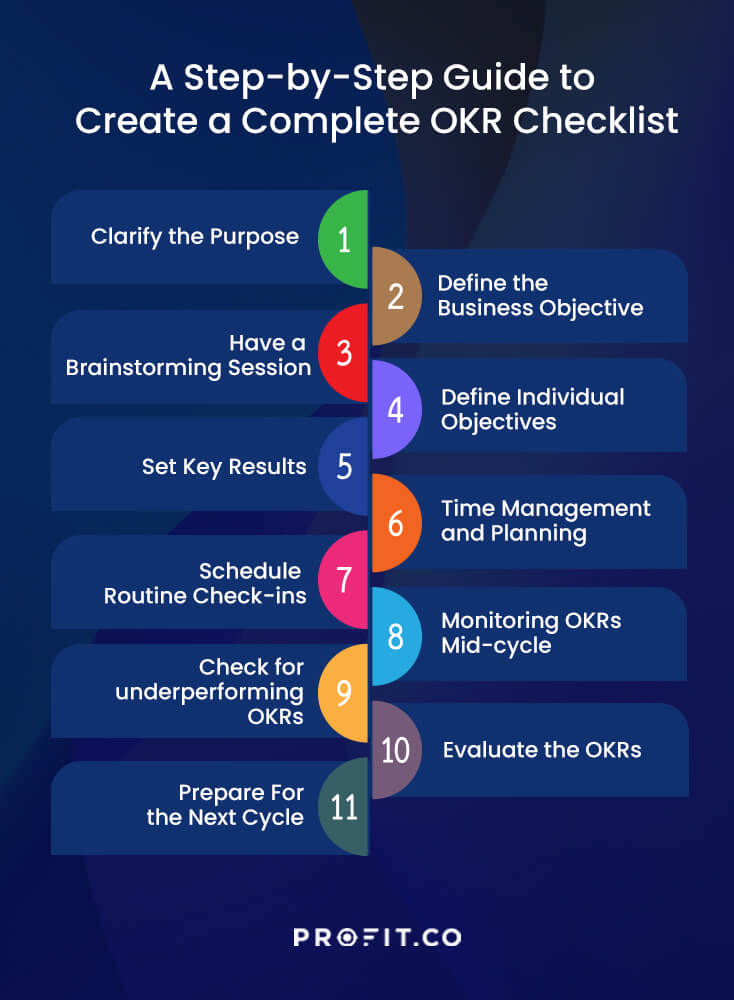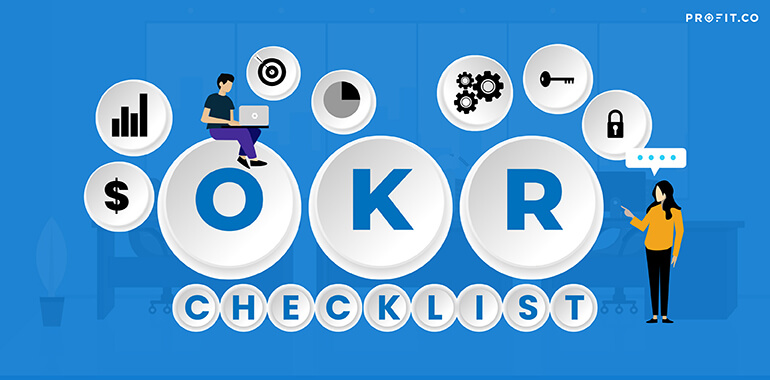OKR Checklist
OKRs (Objective and Key Results) are meaningfully framed Objectives and Key Results designed and tracked to improve business performance. The definition of OKR is to set objectives for the future and measure those objectives with Key Results.
Objectives are the broad goals of a company, department, or person, and the key Result is the success measurement of that objective.
The OKR checklist is a structure that focuses on helping companies with goal setting and their management. The OKR checklist allows you to align your overall business goals with daily tasks for efficient execution. Successful businesses such as Netflix, LinkedIn, Google, and Adobe achieved their ambitions through concrete actions guided by the OKR checklist.
According to former CEO and Google co-founder, Larry Page, “OKRs have helped lead us to 10× growth, many times over.”
Let’s discover why you need an OKR checklist, the different types, and how to complete your OKR checklist.

What is an OKR Checklist?
Most companies set objectives and goals that every department and team member should achieve yearly. However, most of these goals remain unaccomplished due to ineffective processes.
Adopting an OKR framework mitigates this failure. It aligns the company and monitors how measurable goals progress. The framework divides the goals into minor focus areas that are easy to track. The best way to monitor the OKR framework is using an OKR checklist.
The checklist is one of the most high powered productivity tool ever discovered.
Importance of an OKR Checklist
An OKR checklist ensures everyone understands the value and essence of OKRs to the company.
Aligning the Entire Organization
Effective communication makes it easier to set realistic and achievable goals. An OKR checklist helps the leaders ensure the teams collaborate effectively while keeping the priorities clear.
All team members know the items on the OKR checklist and how their key results relate to the overall objectives. They can remain focused on areas that build value for the business.
Ensuring Commitment
Setting clear goals without a plan to ensure commitment can easily lead to failure. An OKR checklist helps you to remain committed to your goals by holding everyone accountable.
Encouraging Improvement through Actionable Goals
OKRs focus on continuous growth and improvement. The top management can determine the type of goal and can be bold-stretch goals. Teams can improve as they progress through constant assessments and reviews.
What Are the Different Types of OKR Checklists?
There are three primary types of OKR checklists.
The preparation checklist has a guideline to assist team leaders in conveying the OKR framework’s benefits to the company.
A brainstorming checklist directs the team to think about applicable OKRs and the possible ways of achieving them.
An action checklist will assist your team in coming up with a new, enhanced structure. It ensures your team implements OKRs and monitors their success.
Are you looking for comprehensive goal management Software? You can get started on Profit.co completely free today!
A Step-by-Step Guide to Create a Complete OKR Checklist
With all team members aware of the importance of OKRs, the next step is creating an OKR checklist to implement the OKRs.
Clarify the Purpose
It’s easier to understand your role and purpose in a company if you know the vision you’re working towards.
- Start with the company’s values, vision, and mission
- Clearly explain the company’s long-term goals
- Elaborate on your business strategy and plans to achieve the goals
- Define the Business Objective
- Your business objectives should be ambitious and focused on ways the company can move forward in the next few years.
- Determine your long-term goals
- Ensure your objectives can direct the company toward success
- Assist team members with setting goals that align with the objectives
Have a Brainstorming Session
The team can be motivated by engaging them during discussions and planning sessions.
- Hold a brainstorming session with your team to understand their opinions
- Analyze the areas that require priority
- Elaborate that goals should be inspiring but practical and achievable
- Ask team members the desired results they wish to achieve using the objectives
- Suggest splitting the desired results into small measurable units they can use to track real-time progress
Define Individual Objectives
A leader must help team members evaluate individual goals based on the plan in the OKR framework.
Some questions to help you achieve this include:
- Why does your team consider a particular objective important?
- Does the objective align with the overall company goals?
- What are the limitations of achieving the objective?
- What’s the acceptable time limit for completing the objective?
- Can you split the objective into small quantifiable goals?
Set Key Results
It’s best to allow team members to set individual measurable key results to retain motivation. You can set correct key results by considering these questions:
- Does every objective have specific vital outcomes?
- Is the particular objective achievable?
- Is it practically measurable through traceable progress?
Time Management and Planning
It’s essential to determine how to set OKRs, frequently grade the OKRs and create new ones for the next period. You can start by outlining the annual objectives and then break them down into smaller quarterly goals.
Remember that:
- The team, individual, and company goals should remain aligned. Team members should have complete visibility when you set new OKRs
- Explain when and how performance grading will take place
- Address the potential challenges along the process and how to deal with them
Schedule Routine Check-ins
Routine check-ins prevent miscommunication and bridge communication gaps when working.
- Have regular meetings to monitor the progress
- Evaluate whether work processes are in the correct order of priority
- Determine whether the plan is working as expected
- Investigate pain points and how to resolve them effectively
Monitoring OKRs Mid-cycle
It’s essential to monitor OKRs in real-time to determine the effectiveness and identify areas that need changes.
- Grade the team members based on the real-time progress
- Look for early red flags and address them
- Provide actionable feedback and suggestions
Check for Underperforming OKRs
It’s not possible to anticipate all issues from the start. You can determine unresolved issues through these questions:
- Does everyone understand the team and individual objectives?
- Do the teams know each other’s objectives?
- Where does work overlap?
Evaluate the OKRs
Each OKR cycle should close with a grading or scoring process. It’s the best way to assess the progress of an objective.
- Split the grading into reflections, subjective evaluation, and objective grading
- Note the critical results as incomplete or complete.
- Determine the percentage achieved for the key result
Prepare For the Next Cycle
Evaluating the challenges and achievements of the previous cycle helps to plan the way forward for better results.
- Determine whether to reduce or increase the OKRs to enhance performance
- Identify the last cycle’s pitfalls and implement ways of fixing them
- Roll over any important unachieved objectives of the prior cycle
Sample OKR Checklist
Here’s an example of a detailed OKR checklist:
- Familiarize with OKR method and approach
- Assemble your OKR Project Team
- Who are the champions, executives, and project owners in this process?
- Define your OKR cycles
- Set goals. Will they be annual, and when does the year start?
- Schedule check-ins monthly, weekly, or bi-weekly
- Plan your Rollout
- Is it a company-wide project, or will you start with a pilot group?
- Is it mandatory for all departments to participate?
- Will all team members have OKRs, or will it be on the department or team level?
- Rollout Communication and Training
- Does everyone understand why OKRs are necessary and important?
- Is everyone familiar with the tracking platform?
- Can the managers, team leaders, and OKR champions train others on OKRs well?
FAQs
What’s the Difference Between KPIs and OKRs?
The main difference between KPIs and OKRs is the intent of setting the goal. KPIs (Key performance indicators) evaluate the company’s performance over a certain period.
OKRs are more ambitious goals that form a strategic framework that changes with time. This framework consists of various KPIs.
How Many OKRS Should I Have?
There’s no definite limit on the number of OKRs you should have. However, it’s best to have ten objectives or less, each with three to five key results.
How Long Should an OKR Cycle Be?
Generally, most OKR cycles take three months. If you’re a small or medium-sized business owner, setting a shorter period is best because you need more flexibility.
Conclusion
The OKR framework makes it easier to engage all team members, prioritize projects and align with the business objectives. Due to the measurable outcomes, team members can evaluate how they contribute to the company goals.
However, even with a complete OKR checklist, it’s often challenging to implement and track the various steps. The best way around these challenges is by using Profit.co OKR Management Software. The intuitive OKR app allows you to create OKRs with the OKR templates and schedule weekly reviews and check-ins.
You can monitor progress visually and take action through the company dashboard. Schedule a
free demo today and discover new heights of business success.

